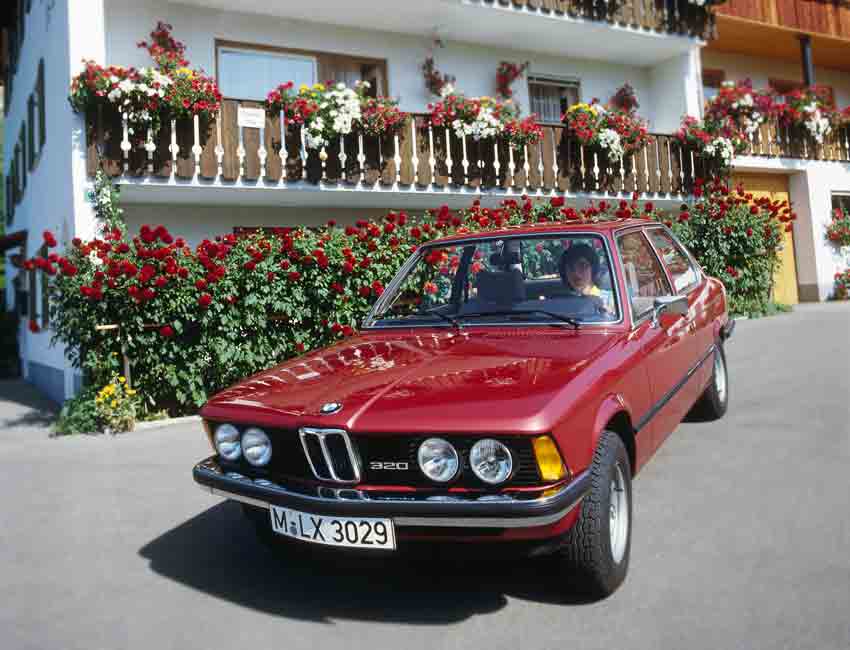The Complete BMW 3 Series Generations and History
The 3 Series is one of the most popular and long-standing Series in the BMW history. The well-received model has been around since 1975 and had launched the sixth generation BMW 3 Series in May of 2015.
Originally appeared in the sporting compact segment, the line-up was produced to replace the legendary BMW 2002 Coupe. Today, the 3 Series is one of the most popular models that the brand offers. According to BMW, sales of the 3 Series 4-door Sedan and Sports Wagon accounted for roughly 25 percent (14 million sales) of total BMW worldwide vehicle sales.
The First Generation: BMW 3 Series E21
The first BMW 3 Series E21 North America version began production in 1976. The 3 Series came to the U.S. as the 1977 model. The BMW E21 known as the 320i was the only version made available for the U.S. market at the time. The agile 2.0 liter 4-cylinder, 2-door Sedan was slightly larger than the retired BMW 02 Coupe.
The BMW 320i E21 2.0
Rated at 110 HP, the engine of the 1977 BMW 3 Series E21 2.0 US version was an efficient M10 B20 Bosch K-Jetronic fuel-injected inline 4-cylinder. The E21 was paired with a 4-speed manual transmission and has a top speed of 103 MPH. The first 320i US production model year ran from 1977 to 1979.
The BMW 320i E21 1.8
A variant model of the BMW 320i fitted with a 1.8-liter engine became available in the US market in 1979. The E21 1.8 was rated at 101 HP with the same 4-speed manual transmission as the E21 2.0.
The BMW 320iS E21 1.8
Another US model variant of the E21 was the BMW 320iS with a 1.8-liter engine first produced in 1980. The 320iS E21 was rated at the same horsepower as the 320i E21 at 101 HP, but it was fitted with an upgraded 5-speed overdrive manual transmission.
BMW 320i E21 Was “The World’s Best Sedan”
The 320i rear-wheel-drive boasted classic BMW façade. The new sports sedan was an instant hit. The BMW 320i, in fact, was voted by readers of the most popular European car magazine “the world’s best sedan” in vehicle class of 2-liter and under. By 1983, worldwide sales of the first generation 3 Series (include the BMW 316, 318, 320, 320i) had reached an astounding 1.4 million units.
The Second Generation: BMW 3 Series E30
Versatility and innovation have always been the key factors for BMW’s success in the industry. From 1983 to 1993 (U.S. models), the second generation of 3 Series continued to gain popularity around the world. The first to be brought on stage was the BMW 318i. It was equipped with a small 1.8-liter injected 4-cylinder rated at 101 HP, and it went from 0 to 60 mph in 11.6 seconds.
The BMW 318i E30
Although ticketed at double the price of its predecessor 320i, the newly released BMW 318i came in with the same 2-door body style and similar cosmetic setup as the outgoing model. The price increase had reasonable justification, and it came from the aerodynamically tweaked constructions and the significant emphasis on body strength.
Immediate to follow was the release of the BMW 325e. This model was a bigger and bolder statement piece. Featured the same inline 6-cylinder as the 528e, the 2.7-liter, 2-door Sedan possessed 121 HP and went from 0 to 60 mph in 8.9 seconds.
The BMW 325es and 325i/is E30
In 1985, the 2-door model received a 4-door Sedan variant and was upgraded to the four-speed transmission. In addition, a 2-door 325es (sports version of the 325e) with antilock four-wheel disc brakes and prominent front spoiler emerged as the 318i slowly phased out of the line-up.
Additional North America lineups included the 325i/is (1987-1991). The model was equipped with 168 HP, 164 lb-ft of torque, and it went from 0 to 60 mph in 7.4 seconds.

The Third Generation: BMW 3 Series E36
During 1991 – 1999 (U.S. models), the reinvented BMW E36 emerged with more sophisticated enhancements. It started off by making the 4-door saloon its flagship body type. Then, the 3 Series made several important changes which paved the road for its future generations.
The BMW 325i E36
Officially adopted the “dolphin shape” exterior design, the 3 Series E36 was built out with improved proportions and the perfect BMW signature 50/50 weight distribution.
The third generation featured the 3.0-liter, DOHC 24 valve, 6-cylinder engine in the BMW 325i E36 with an aluminum head fitted in the heart of the machine (except for entry-level models). Its output was increased to 189 HP and went from 0 to 60 mph in just under 6.9 seconds, which closely matches the record of the first-generation BMW E30 M3.
The BMW E36 Model Lineup
The 4-door Sedan was released in the U.S. market in 1991 as the 1992 model, while the Coupe and Convertible came about in 1993 and 1994 respectively.
The BMW E36’s model lineup in the U.S. Market included the following versions:
- 318i, 318is, 318ic, 318ti
- 323i, 323is, 323ic
- 325i, 325is, 325ic
- 328i, 328is, 328ic
The New Z-Axle Rear Suspension in the BMW E36
There was much effort made to the design and technology improvement for the BMW E36. One distinctive upgrade made to the chassis of the E36 was the replacement of the semi-trailing arm suspension by the Z-axle rear suspension with the multilink system.
Except for the hatchback model – BMW Compact (known as the E36/5), all E36 adopted the new Z-axle rear suspension. The new technology enabled better tire traction and improved handling on rough roads to achieve smoother rides.
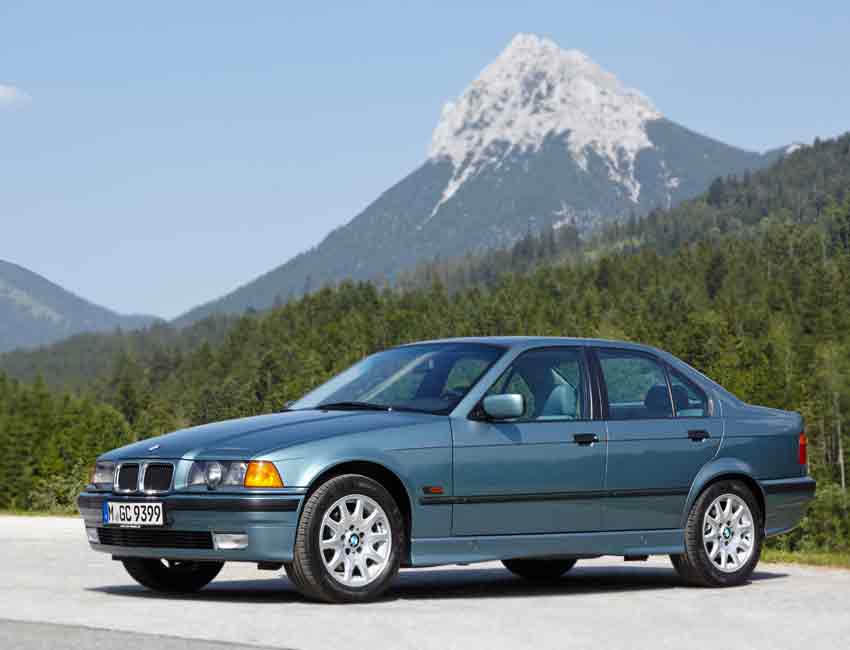
The Fourth Generation: BMW 3 Series E46
During 1998 to 2006, came the BMW E46 generation for the US market. By this time, the 3 Series had become a well-received popular model in the United States and worldwide.
Physically, the BMW E46 had a subtle increase in body size, taking the measurements to 176 inches in length (1.5 inches increase from the E36 model) and 107.3 in wheelbase (1-inch increase from the E36 model).
The BMW 328i and 323i E46
The BMW 3 Series E46 4-cylinder version was never made available to the U.S. market, and all the model lineups brought over to America were equipped with the 6-cylinder powerhouse. The 2.8-liter, inline 6-cylinder 328i Sedan, for example, came about in 1999 with the 323i model.
The BMW 328i at the time featured an impressive 193 HP at 5,500 RPM with 206 lb-ft of peak torque, while the BMW 323i was composed of a smaller 2.5-liter engine with 170 HP and 181 lb-ft of torque.
The new inline-6 engines utilized lighter aluminum block to achieve a reduction in unsprung weight. Improvements were also made to the Double VANOS variable valve timing system as well as the dual resonance intake.
The BMW 323 and 328 E46
In the year of 2000, BMW 323Ci and 328Ci Coupe models, 323Ci Convertible model and the 3 Series Wagon 323i came about. In the next two years, both the BMW 328 and 323 engines received power upgrades (except for the wagon model).
The BMW 325 and 330 E46
In 2001, the 2.5-liter 323i inherited the name 325i, and its output was increased to 184 HP. The 328i, on the other hand, swapped out its engine with a bigger 3.0-liter, 225 HP instrument and became the 330i.
In addition, the all-wheel-drive xDrive option was brought back to the 4-door Sedan and the Wagon versions to create the 325xi and the 330xi respectively.
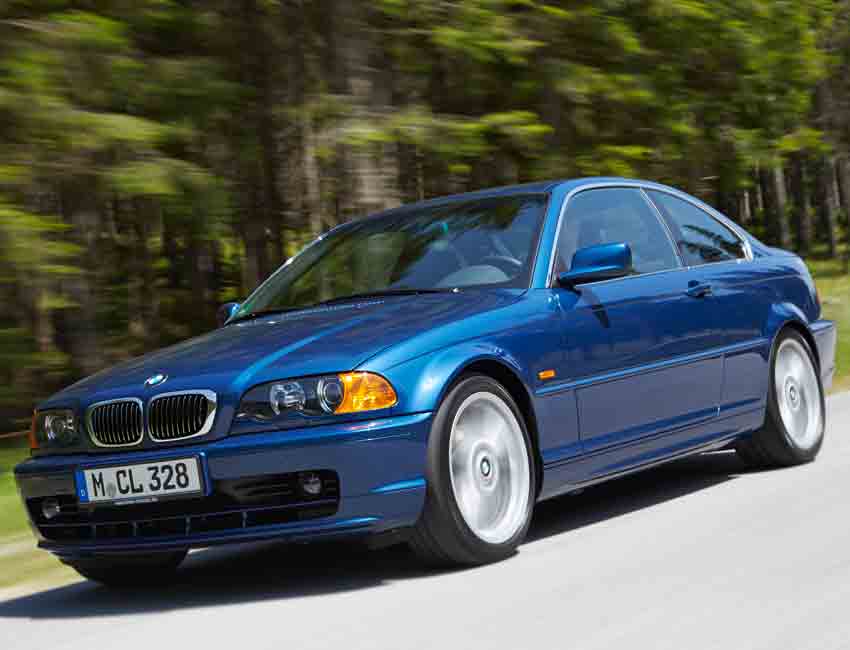
The Fifth Generation: BMW 3 Series E90, E91, E92 and E93
BMW E90 marked the fifth generation of the BMW 3 Series. In 2002, by the end of the BMW E46 era, the 3 Series had already received a facelift with a redesigned front and brand-new tail lights.
2006 was the beginning of the BMW E90 3 Series Sedan and the E91 Sports Wagon period. With it, came the BMW E92 3 Series Coupe as well as the E93 3 Series Convertible.
Significant cosmetic and mechanical changes were done to improve the design and performance of the fifth generation 3 Series. First, the transition from the BMW E46 to the E90 triggered dimension increase. The longer wheelbase (1.4 inches longer than E46), the wider tracks (1.2 inches wider than E46), and a roomier interior brought more balance to the new 3 Series E90.
The Upgraded BMW 325i and 330i
Then there was the power boost. Both the 325i and the 330i were upgraded to the new 3.0-liter, inline 6-cylinder engines. 325i was rated at 215 HP while the 330i achieved a 255 HP with additional performance modifications that included the three-stage induction system.
New technologies such as the iDrive system and Active Steering were also introduced to make the driving experience even more exceptional.
The BMW 335i E93 Hardtop Convertible
The very first retractable hardtop was introduced in 2007 in the BMW Convertible E93. The retractable hardtop was a breakthrough with its seamless operations and the sporty design.
The Convertible was presented with the same BMW TwinPower Turbo technology and was debuted in the 335i. The hardtop convertible pulled 300 HP with 300 lb-ft of torque and went from 0 to 60 mph in just around 5 seconds.
The BMW 328i and 335i
The introduction of the world’s first in-line 6-cylinder, TwinPower Turbo engine also brought about changes in the BMW 325i and 330i. Both models were retired and replaced by the novel 328i and 335i. The BMW 328i featured a 3.0-liter inline 6-cylinder with 230 HP and 200 lb-ft of torque. While the BMW 335i was paired with the TwinPower Turbo system rated at 306 HP and 300 lb-ft of torque.
The new 3 Series was available in Sedan, Coupe, and Convertible forms, with xDrive options offered to the Sedan and the Coupe versions. In 2011, the 4-cylinder and 6-cylinder TwinPower Turbo engines were made available in the 328i and 335i respectively. This finalized the chapter for the fifth generation of the BMW 3 Series.

The Sixth Generation: BMW 3 Series F30, F31 and F34
2012 was the year that the sixth generation of BMW 3 Series F30 first introduced to the U.S. market.
We were looking at a lengthier body (3.7 inches longer than E90), a wider front and backtrack (1.46 inches wider in the front and 1.85 inches wider in the back compared to E90), as well as a brand-new chassis based on a lengthened wheelbase (2 inches longer than E90). The overall profile was enlarged to create more interior room for added comfort.
In addition, the widened door-opening angles and a 20-liter increase in the trunk space also contributed to the overall capacious impression.
The BMW 3 Series F30
The revamped BMW 3 Series F30 was equipped with a brand new 2.0 liter, 4-cylinder engine with High-Precision Direct Injection, and VALVETRONIC variable valve. The new lineup was rated at 240 HP and reached 0 to 60 mph in 5.6 seconds (0.3 seconds faster than the outgoing E90 328i).
The slightly reduced horsepower brought about the benefit of weight reduction and fuel efficiency. In addition, the system featured BMW’s new TwinScroll turbocharging with Double-VANOS variable camshaft timing which further perfected the new 3 Series’ driving technologies.
Aesthetic enhancements were noticeable throughout the new BMW 3 Series F30. From the distinctive outlines to the muscular façade, every angle was prominently defined to accentuate the sportiness of the body. Even the upgraded interior gave off the look and feel of a premium, classic BMW Sedan. Furthermore, the affordability of the 3 Series was by no means a sacrifice to the quality or the upscale comfort.
The Latest BMW 3 Series
The latest BMW 3 Series packs all the upside of a mid-sized Sedan. Its compact yet efficient dimensions are the perfect demonstrations for supreme handling, agility, convenience, and efficiency. Its signature BMW design synchronizes with the rest of the BMW lineup.
Today, from its aerodynamic exteriors to the innovative technologies, the new 3 Series continues to lead the Sedan Segment with its new technology and achievement. See our complete guide on the BMW 3 Series.
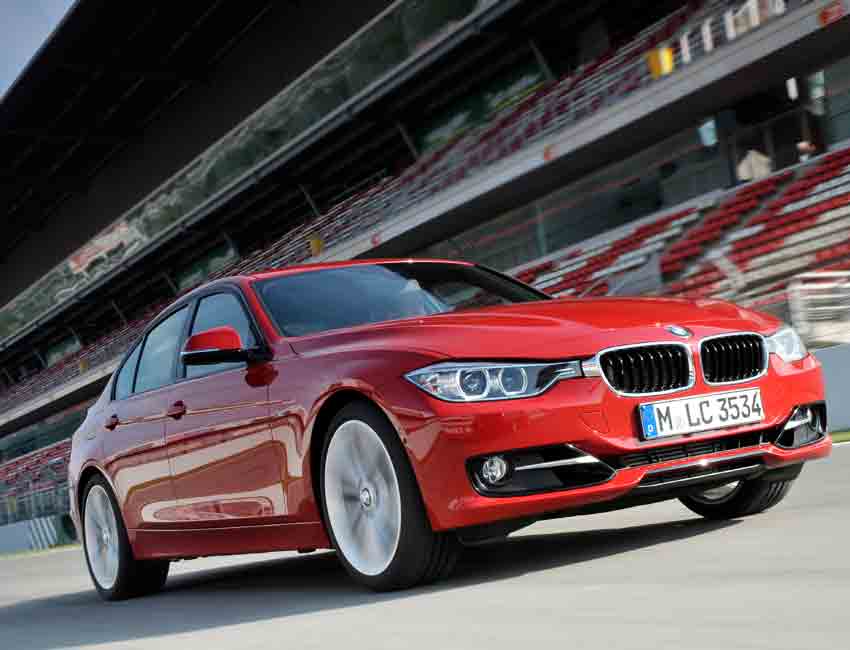
The BMW 3 Series’ Transformation Over Four Decades
The BMW 3 Series came a long way since its debut in Frankfurt Auto Show more than four decades ago. At its sixth generation, the iconic model has evolved and transformed. The latest generation of 3 Series retired its 2-door variants and created a brand-new BMW 4 Series Coupe. The prevalent 4-door Sedan became the classic representation of the well-received BMW 3 Series model type.
We are excited to see what is in store for this classic BMW model in the new generations to come.
Also see our complete guide to the BMW M3 history and evolution.
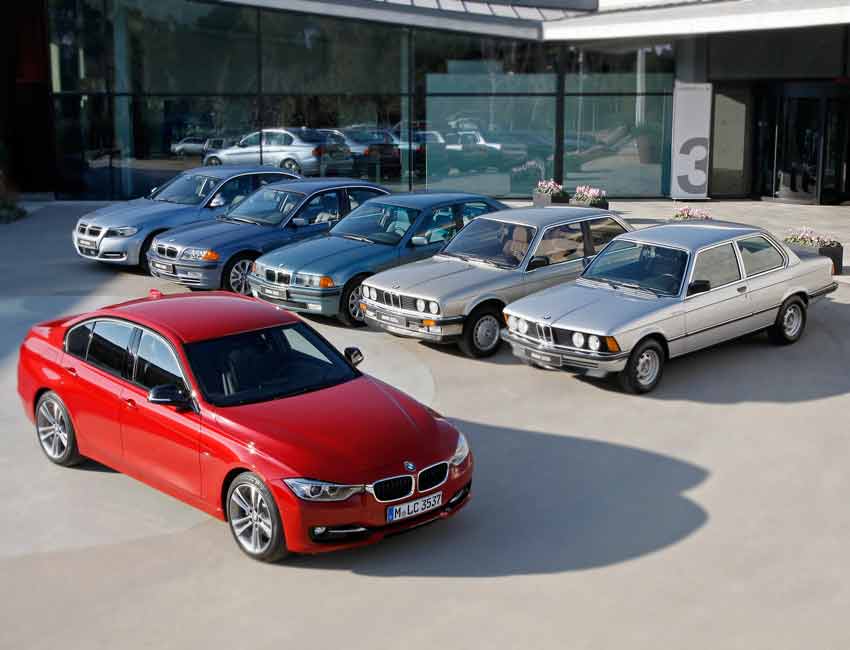
You Might Also Be Interested In…
Can BMW Charge at Tesla?
Can BMW Charge at Tesla? As of now, BMWs can't directly charge at Tesla Supercharger stations because Tesla uses a proprietary connector. However, with the right third-party adapter, BMW owners might be able to make it work, but it's always good to double-check...
Are BMW Motorcycles Reliable? A Comprehensive Dive into the World of BMW Bikes
Are BMW Motorcycles Reliable? BMW motorcycles are renowned for their top-notch engineering and build quality, making them a reliable choice for riders around the world. Whether you're hitting the open road or tackling rugged terrains, you can count on a BMW to be a...
Can BMW Take 87 Gas? Discover the Truth Behind the Octane Debate!
Can BMW Take 87 Gas? Certainly! While a BMW can technically run on 87 octane gas, it's not the optimal choice. BMW recommends using premium fuel for most of their models to ensure the best performance and longevity of the engine. So, while it might be tempting to...
Embrace the Future with the BMW Genius Program
You know, they often say that 'knowledge is power'. Well, that's never been truer than in the case of BMW's groundbreaking initiative - The BMW Genius Program. Tailor-made for every BMW enthusiast out there, this program sheds light on the latest technological...
A Comprehensive Dive into the BMW N63: A Blend of Power, Performance, and Precision
Hey there, gearheads! Welcome to a deep dive into the fascinating world of one of the most renowned engines out there: the BMW N63. We're about to embark on an exciting journey, exploring the good, the bad, and the powerful of this engineering marvel. Are you ready...
How BMW TPMS Works: A Comprehensive Guide
When it comes to innovation and performance, BMW never falls short. But how well do you know the intricacies of your vehicle, specifically the Tire Pressure Monitoring System (TPMS)? Let's take a journey to understand how BMW TPMS works. How BMW TPMS Works So,...
Can BMW Keys Be Reprogrammed? Your Comprehensive Guide
Ah, the wonders of technology! It's in everything these days, from the appliances in our homes to the phones in our hands. And of course, it's a big part of our beloved vehicles too, particularly in prestigious brands like BMW. One feature that often leaves car...
How BMW VANOS Works: A Comprehensive Guide to Variable Valve Timing
Introduction Welcome to our comprehensive guide on the fascinating topic of how BMW VANOS works. If you've ever wondered about the inner workings of your BMW engine and how it achieves optimal performance, you're in the right place. In this article, we'll take a...
How BMW Models Work – BMW Model Names Explained
BMW, or Bayerische Motoren Werke, a name synonymous with luxury, performance, and automotive engineering, often leaves many of us scratching our heads when it comes to deciphering their model naming conventions. Do you ever wonder what these series of letters and...
Will BMW Wheels Fit Mercedes? Exploring the Compatibility Between Two Iconic Brands
When it comes to automobiles, BMW and Mercedes-Benz are two of the most renowned and prestigious brands in the world. Both manufacturers have established themselves as leaders in the industry, producing vehicles that exude luxury, performance, and style. However,...

